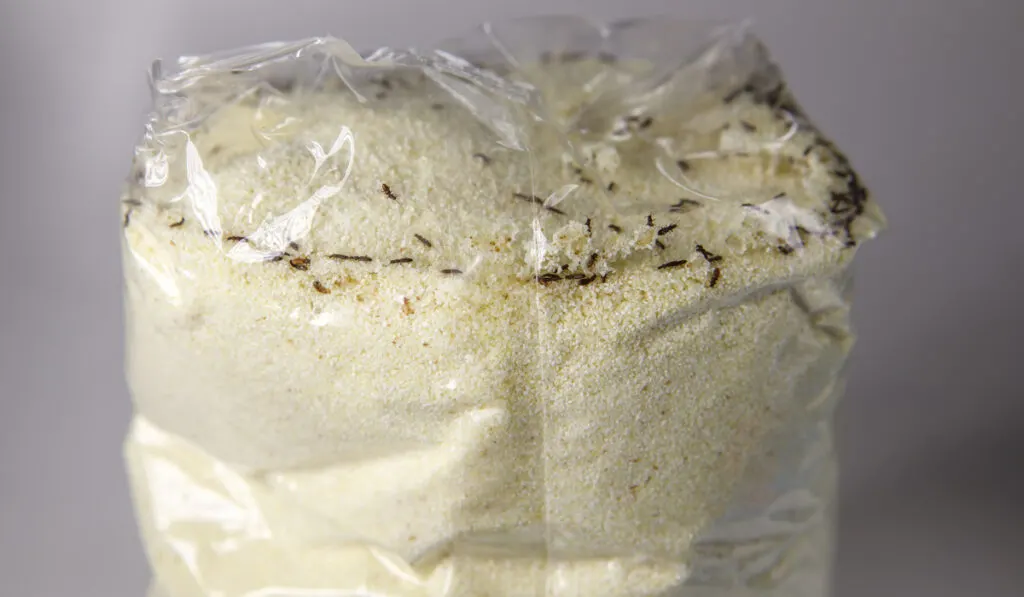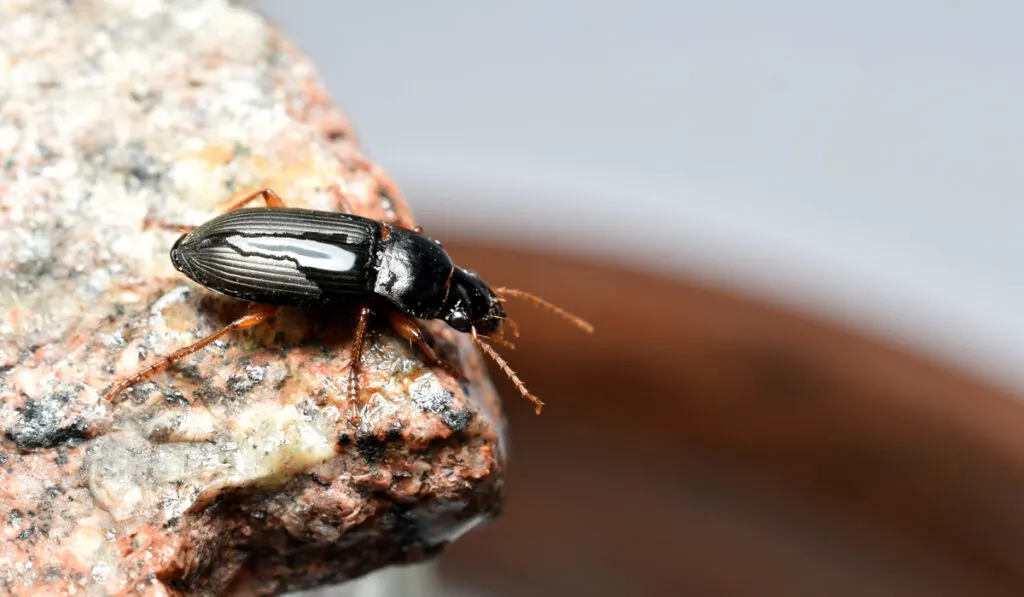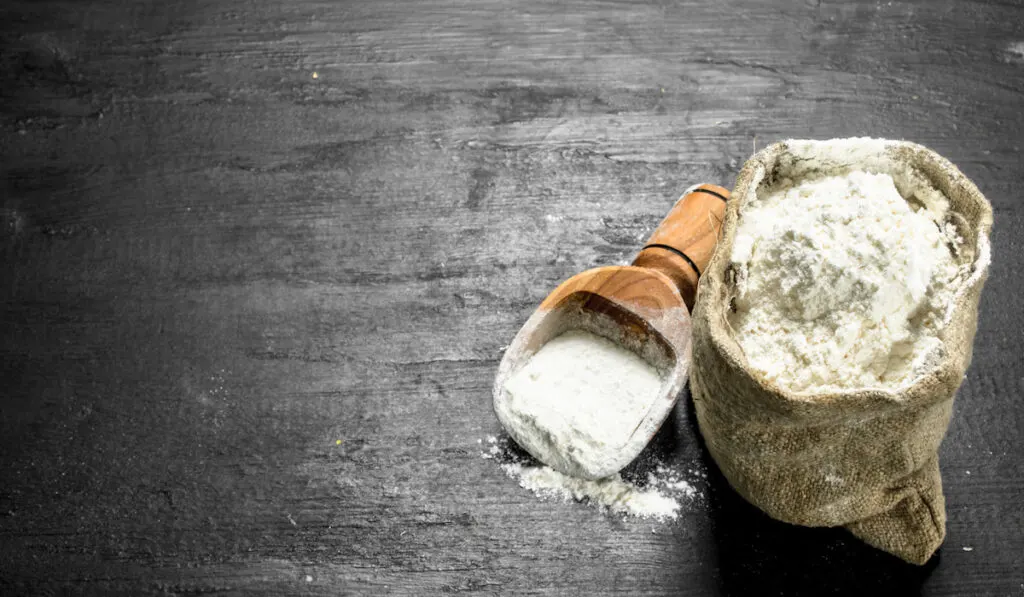Table of Contents
What are Flour Beetles?
Flour beetles are pests that infest grain-based foods like cereals, and flour, and are often found in these items when they are stored. For this, they are common in home pantries, grocery shops, and food warehouses. Flour beetles have tiny, flat oval bodies of about a tenth of an inch in length.
Although native to Asia and Africa, two of the most common flour beetles, the confused and red flour beetles, are extremely prevalent and are a big nuisance in the United States.
As aforementioned, flour beetles are grain pests, but oddly, they do not feed on whole grains, but rather the dust and processing residues of processed grains. Apart from cereals and flour, flour beetles also attack beans, spices, pasta, dry pet food, seeds, almond, chocolate, nuts, and dried flowers.
They have mouthparts adapted for chewing, but they do not bite, scratch, sting, nor hurt people, although the red floor beetle might induce some allergic reactions. Furthermore, they are not known to spread infections or illnesses and do not damage a home structure or any furnishings.

However, they may contaminate foodstuffs in which they are hosted because they lay eggs there while eating. For this, flour beetle-contaminated products are not recommended for human consumption.
Owing to their small size, flour beetles can be hard to spot, but signs of their infestation might include cast skins, dead bodies, fecal pellets, and excretions, resulting in a highly pungent odor from the infested food.
3 Types of Flour Beetles
Flour beetles are very similar insects with just a few distinguishing features, such as their antennae, marking the difference between the red and confused flour beetles.
However, telling their difference is only for practical purposes since their control measures are all the same. Let’s have a detailed look at each of the flour beetles below.
Confused Flour Beetle (Tribolium confusum)
The confused flour beetle is a dark-loving pest beetle known for infesting stored flour and grain. For this, they are common in silos, food warehouses, grocery stores, and homes.
However, they cannot eat whole, undamaged grains, but rather go for the broken grain, grain dusts and other starchy materials, peas, beans, spices, dried plant roots, rice and dried fruits, and yeast.
Interestingly, the name “confused flour beetle” was coined for the pest, not because of its behavior, but because of the confusion caused by distinguishing it from the red flour beetle. Both are very similar with just the difference in their antennae being the distinguishing factor.
The confused flour beetle’s antennae constantly grow in size through time and have four clubs, while a red flour beetle has three. It also has a fairly flat reddish-brown body and they do not fly.
Among the stored product insects, the confused flour beetle has one of the highest population growth rates, with each female laying between 200 and 1000 eggs loosely in food over their adulthood.
Their breeding takes place optimally at a temperature range of 68-98°F, even though it can breed at lower temperatures. On the other hand, the larvae develop optimally at a temperature ranging from 89-95°F.
The confused flour beetle is a generalist feeder, whose feeding activities, dead bodies, and fecal pellets are directly linked to food damage and contamination. They also release a noxious secretion when laying eggs, resulting in a foul odor, also making the food product unsuitable for consumption.
When your grain or flour is heavily infested, these secretions make the food have a pinkish tinge and encourages the growth of mold.
Red Flour Beetle (Tribolium castaneum)

Mainly found in tropical and sub-tropical countries, the red flour beetle is a stored grain pest for a variety of stored grain products, mainly feeding on maize grains. Adult red flour beetles are slightly smaller than the confused flour beetle, with a flattish reddish-brown body that is slightly curved on the sides.
They have reddish-black eyes and clubbed antennae, with the last three segments gradually widening compared to the preceding segments. Their wing cases are ridged along the edges, while the head and upper thorax are covered with minute punctures.
They are either on the surface or deep within the grain, and they quickly run for cover when disturbed. The adult red flour beetles have short-distance flight capabilities.
They have sticky eggs that are cylindrical and are white or colorless. An adult female may lay 300 to 400 eggs over her 5–8 month lifespan.
At the larval stage, they become yellowish-white with slender, cylindrical bodies covered with fine hairs. They also have two long extensions at the back end of the abdomen.
The pupa, on the other hand, is also yellowish-white, but without a cocoon, and later on changes to brown.
Under the optimal conditions of 95°F and 60–80% relative humidity, the eggs will fully develop into larvae after 3 days, the larvae pupate in 16 days, and the pupae transform to adults in 5 days. All the stages cause significant food damage.
Owing to the fast development rate, there can be up to 5 generations per year.
The red flour beetle is a scavenger that feeds on grain damaged by other pests or those damaged during transportation or storage, and cannot feed on whole undamaged grains. Like the confused flour beetle, the red flour beetle causes food damage through its feeding activities, fecal pellets, dead bodies, and foul-smelling secretions. Their presence also encourages growth of mold in food, rendering it unfit for consumption.
Adult red flour beetles are generally active and rapidly and irregularly move about when disturbed. They can also fly and are at times attracted to light, making it easy for them to disperse from their initial infestation point and easily spread to other potential host points.
Destructive Flour Beetle (Tribolium destructor)

Destructive flour beetles grow slightly larger than the other two species when fully developed. Both the adult and larvae feed on crisp bread, birdseed, pasta, and oatmeal flakes and for this, they are most likely found in stores, bakeries, and mills, from where they spread to homes.
Adults have a dark-brown pigmentation, or brown and black, while the larva has a shiny yellow-brown hue, and may grow twice the size of the adults. Its lower abdomen tip has two sharp extensions that curve slightly upwards.
Their presence in food naturally contaminates food since they lay their eggs while they feed, and this comes with a foul-smelling excretion that encourages mold. All this makes the infested food unfit for human consumption.
6 Tips for Getting Rid of Flour Beetles
Flour beetles might be different but their control measures are similar. Traditionally, it is advisable to dispose of the affected food products and inform a professional right away if there are other foods in the store, or if you suspect any pest infestation in your grain or flour. Here are a few ways to best manage a pest infestation.

- Pest detection – at low infestation rates, flour beetles can be hard to detect. However, holes in seeds and grain and the presence of grain dust is the main sign of infestation. In large numbers, both the larvae and adults are visible, alongside the dust they create when feeding. Their sticky eggs can also be detected in the storage containers, accompanied by a pungent smell.
- Routine and tradition – Good store hygiene can easily help manage flour infestations. Such traditions include vigorous cleaning of the store between harvests and removing and burning or disposing of the remaining infested product. Also, remove and fumigate wood with any dust residues.
- Physical control – sieving can remove broken grain particles and dust, and subsequently reduce the number of pests, but will not entirely get rid of them. However, the addition of inert dust such as ash and clay will ensure the total extermination of these insects through desiccation.
- Controlled environment – freezing or heating stored product kills the flour pests. Also where possible, controlled environments with low oxygen levels and high carbon dioxide levels are good for grain and flour product storage.
- Chemical control – rarely, chemicals like pyrethroids and fumigants are used to control flour pests. However, these insects may develop immunity against some pesticides, and is therefore recommended to use diverse classes of chemical treatment to avoid the risk of immunity. The insecticide sprays and fumigants are sprayed around cupboards, drawers, and stores, but always ensure to remove all food products, containers, and utensils in the treatment area. Before applying the insecticide also, ensure that it is recommended for food storage areas and is safe for indoor treatments, otherwise it is not recommended.
Conclusion
Flour beetles can be a real menace in your store or home since they are hardly noticed until they are in large numbers. Hopefully, this article was informative on how to best assess, detect, and control the pest, no matter the infestation rate.
Resources
- https://www.goallpest.com/flour-beetles
- https://extensionentomology.tamu.edu/insects/flour-beetle/
- https://extension.psu.edu/confused-flour-beetle-and-red-flour-beetle
- https://stopzbugs.com/blog/what-are-flour-beetles/
- https://keys.lucidcentral.org/keys/v3/eafrinet/maize_pests/key/maize_pests/Media/Html/Tribolium_castaneum_(Herbst_1797)_-_Red_Flour_Beetle.htm
- https://www.grainscanada.gc.ca/en/grain-quality/manage/identify-an-insect/primary-insect-pests/confused-flour-beetle.html
- https://en.wikipedia.org/wiki/Confused_flour_beetle
- https://sisatilojentuholaiset.fi/en/food-pests/destructive-flour-beetle/
- https://entnemdept.ufl.edu/creatures/urban/beetles/red_flour_beetle.htm
